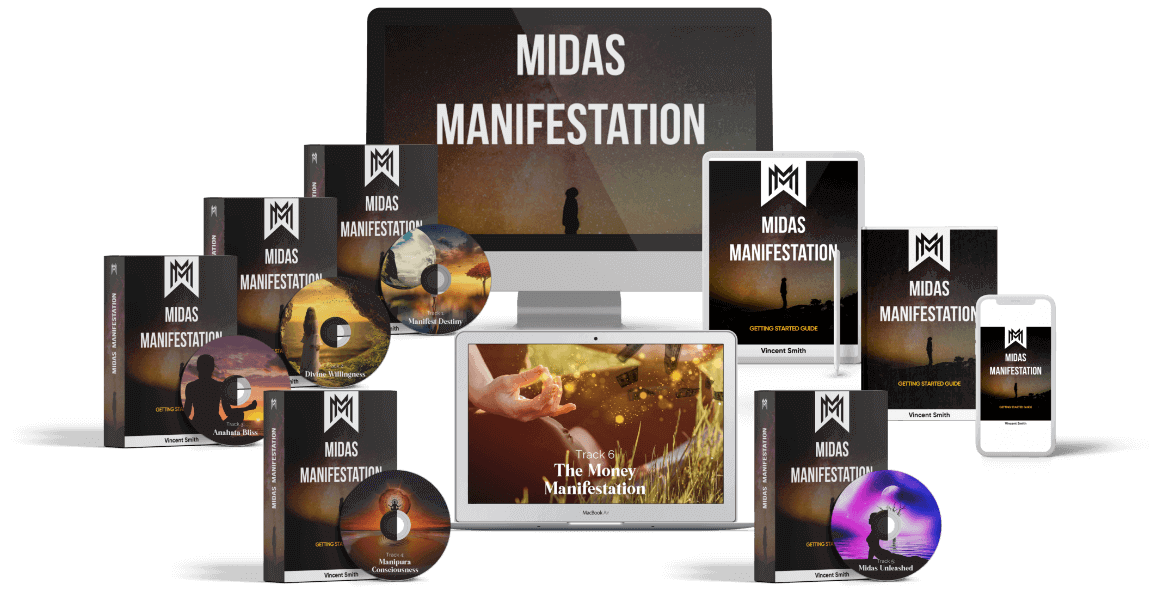Manifestation systems are everywhere right now, and let’s be real—some people swear by them, while others roll their eyes and call it hype. The science behind Midas Manifestation is especially interesting because this program isn’t just about “thinking positive.” It combines chakras, sound frequencies, and the idea of aligning your energy with abundance. But here’s the big question: is any of this backed by science, or is it more in the realm of pseudoscience? Or maybe, like many things, it lives somewhere in between. In this article, we’ll look at the actual research on sound and mindset, explore the psychology of belief and placebo effects, and also point out where the evidence is still missing. By the end, you’ll have a clearer view of what’s practical, what’s speculative, and how to approach Midas Manifestation with both curiosity and critical thinking.
👉 Still wondering if it’s worth your time? Check out my full Midas Manifestation System review to see what’s inside, how it works, and whether it’s the right fit for you.
🔬 What Is the Midas Manifestation System?
When I first stumbled across the Midas Manifestation System, I honestly thought it was just another “get rich quick” scheme dressed up in spiritual language. But once I dug into it, I realized it’s a little different. At its core, it’s a package that combines five audio tracks, a detailed handbook, and a whole lot of talk about chakras, vibrational energy, and sound frequencies. Sounds wild, right? But the way it’s laid out makes it approachable—even for someone who doesn’t spend all their time in yoga studios or metaphysical shops.
The big idea is simple: your energy (your personal vibration) influences what you attract in life. The system is built on the claim that if you align your chakras properly—especially the root chakra tied to stability and wealth—you can improve everything from your financial situation to your health and even your overall outlook on life. Instead of long meditations or complicated rituals, you’re supposed to listen daily to audio tracks tuned to specific sacred frequencies like 288 Hz or 528 Hz. Each track is paired with a chakra, guiding you through a sequence meant to “retune” your energy.
The backstory is where it gets even more interesting. The creator, Vincent, presents himself as a linguist, cultural researcher, and seeker of hidden knowledge. According to his story, he uncovered an ancient manuscript in an old Egyptian bookstore—yep, sounds like something straight out of a movie—and decoded teachings that link sound, consciousness, and wealth creation. Whether you take that literally or as a metaphor, it sets the tone: this isn’t just about affirmations or visualizations, it’s framed as secret wisdom from ancient civilizations brought into modern practice.
Now, the claims are bold. We’re talking about promises of increased wealth, reduced anxiety around money, and even improved health by tapping into vibrational energy. I’ll be honest, I was skeptical at first. But what I found appealing (and why I think so many others give it a shot) is that it doesn’t ask you to blindly believe. Instead, it invites you to experiment—listen consistently, follow the guide, and see if your mindset, habits, and outcomes start shifting.
That’s probably why it appeals to such a wide crowd. On one hand, spiritual seekers love it because it connects chakras, frequencies, and ancient wisdom. On the other, curious skeptics (like me in the beginning) see it as a low-risk experiment. After all, listening to an audio track each day feels a lot more doable than trying to overhaul your entire lifestyle.
For me, the draw wasn’t just the mystical backstory—it was the practicality. Could sound really shift my mindset? Could aligning chakras actually influence how confident I felt in sending proposals or negotiating bills? The system plants that question in your head and then dares you to test it. And honestly, that’s where its power lies.
🎶 Sound Frequencies & Vibrational Energy: What Science Says

When I first heard that the Midas Manifestation System used specific sound frequencies to shift energy and bring in wealth, I’ll admit—I was skeptical. I mean, how could listening to a tone at 528 Hz suddenly change my bank account? But the more I dug into the science (and paired it with my own trial-and-error experience), the more I realized there’s some truth here… with some big caveats.
🧠 How Sound Affects the Brain & Nervous System
Let’s start with what is backed by research. Studies on binaural beats and meditation music show that sound frequencies can influence brainwave states. For example, slower frequencies are linked to calming alpha or theta brainwaves, which reduce stress and encourage creativity. I noticed this myself—listening to the root chakra track at night helped me sleep better, while the solar plexus track at 528 Hz made me feel more energized before starting work. It wasn’t magic; it felt like my nervous system was literally getting a reset.
📉 Stress Reduction & Focus Benefits
Plenty of evidence shows that sound therapy can lower cortisol levels and help with focus. Think about it—people have been using chanting, drumming, and mantras for centuries to calm the mind. When I listened daily, I found myself less reactive to small money stresses. That alone gave me more mental space to take action on opportunities instead of spiraling in worry.
🚧 The Limits of the Research
Here’s the honest part: there’s no direct scientific proof that listening to a certain Hz frequency will manifest wealth or drop cash in your lap. The studies point to reduced anxiety, improved focus, and even pain relief—but not money magically appearing. I had to learn to see the system as a tool for sharpening mindset, not as a slot machine spitting out instant results.
🌊 Why It Still Feels Powerful
So why do people, myself included, feel calmer or more focused after sound sessions? It comes down to state of mind. When your stress drops and your focus improves, you make better decisions. You notice opportunities you might’ve ignored before. For me, that meant finally following up on a client lead after a session—and guess what, it turned into income. The sound didn’t create the money, but it created the conditions where I could act more effectively.
At the end of the day, the science supports the calming and focusing benefits of frequencies. The leap to “wealth manifestation” isn’t proven, but the improved mindset they bring can absolutely influence financial outcomes. And that’s where the real value lies.
🌀 Chakras & Energy Centers: Spiritual Tradition vs. Modern Psychology

When I first opened the Midas Manifestation System handbook and saw all the talk about chakras, my knee-jerk reaction was, “Okay, here comes the woo.” But the more I explored, the more I realized chakras aren’t just mystical ideas—they’re also powerful metaphors for how we experience balance (or imbalance) in life.
🌍 Ancient Roots of the Chakra System
The chakra system comes from ancient Indian traditions, specifically texts like the Vedas that date back thousands of years. The original idea was that humans have spinning energy centers running along the spine, each tied to different aspects of life—survival, creativity, love, intuition, and so on. Back then, they weren’t talking about neuroscience or psychology. They were describing how energy, breath, and consciousness felt during meditation and spiritual practice.
🧩 Chakras as Psychological Metaphors
Fast forward to today, and most mainstream psychology doesn’t treat chakras as literal spinning wheels of energy in the body. Instead, many therapists and wellness experts use them as metaphors for mind-body balance. For example, the heart chakra can represent emotional openness, while the solar plexus chakra reflects confidence and personal power. I’ve found that framing chakras this way makes them easier to work with, especially if you’re not fully sold on the “energy” language.
🌱 Why the Root Chakra Gets Linked to Money
In manifestation teachings, the root chakra is a big deal because it represents stability, security, and survival. When this chakra is “blocked,” you might feel anxious about money, unstable in your job, or always stuck in scarcity mode. When it’s “open,” you feel grounded enough to take risks and build wealth. I noticed this firsthand—when I worked with root chakra practices, I stopped obsessing about every little bill and started making clearer financial plans. That mindset shift alone made me feel wealthier, even before my income changed.
⚖️ Criticisms & Skepticism
Of course, the elephant in the room: there’s no empirical evidence that chakras physically exist. Science hasn’t found spinning energy centers in the body. Critics call chakra work pseudoscience, and that’s fair if you’re looking at it purely through a medical lens. But here’s where I land: even if chakras are “just” metaphors, they’re useful ones. Thinking about them gave me a framework to reflect on areas of my life I was ignoring, like confidence or financial safety. And sometimes, that reflection is the first step toward real change.
For me, the takeaway was this: you don’t have to believe in literal chakras to benefit from the practices. Whether you see them as energy centers or psychological anchors, the work you do with them can still shift how you feel—and how you act. And that’s what actually moves the needle.
🧠 Placebo, Belief & Expectation Effects in Manifestation

One of the most eye-opening parts of working with the Midas Manifestation System wasn’t the sound frequencies or even the chakra exercises—it was realizing how much my belief affected the results. At first, I brushed it off as “mind over matter,” but the more I compared my experiences with research, the more I saw the parallels with placebo studies.
🎭 Belief Shapes Perception & Behavior
Placebo research shows people can feel real relief from a sugar pill, as long as they believe it’s medicine. The body literally responds to the expectation. I noticed something similar: on the days I trusted the process, I approached tasks with energy. On the days I doubted it, everything felt heavy and unproductive. Same audios, same routine—the difference was in my mindset.
📈 Expectancy Theory in Action
Psychologists call this expectancy theory: when you expect something to work, you unconsciously adjust your behavior to make it more likely. For me, expecting that the manifestation work would help made me send out more pitches, follow up on leads, and even negotiate bills I normally avoided. Did the audio track create money? No. But the belief nudged me into actions that opened the door for it.
🍀 “Luck” or Just Proactivity?
I’ve seen this play out with friends too. One swore she got “lucky” with a new job offer right after starting daily sessions. But when I asked her what she’d actually done, she admitted she applied to twice as many roles as usual and networked more boldly. That wasn’t random—it was proactive behavior fueled by confidence. Belief turned into action, and action turned into opportunity.
🌟 Mindset Shifts as Real-World Catalysts
This is why I think mindset shifts matter, even without mystical explanations. When you feel calmer, more optimistic, and less trapped in negative loops, you notice possibilities instead of dismissing them. You take the phone call, send the proposal, start the side project. And over time, those little actions snowball into real results.
For me, the “placebo effect” of manifestation isn’t fake at all—it’s a psychological engine. Whether you call it belief, vibration, or mindset, the mechanism is the same: change the way you expect the world to work, and you’ll change the way you move through it. And that alone can be enough to change the outcome.
📚 Pseudoscience Claims: Where the Evidence Falls Short

When I started exploring the Midas Manifestation System, I was fascinated—but also wary. Some of the claims sounded inspiring, while others raised red flags. And honestly, I think this is where a lot of people get tripped up. There’s a mix of practical, mindset-driven advice and big, bold promises that lean more into pseudoscience. Sorting through the two is what helped me actually benefit from the program without buying into unrealistic expectations.
🌌 Akashic Records & Mystical Databases
The handbook mentions the Akashic records—a kind of universal library where all past, present, and future knowledge is stored. Spiritually, it’s an intriguing idea, and some people swear by it. But from a scientific standpoint, there’s zero evidence such a database exists. I tried some of the visualization practices linked to it, and while I didn’t “download cosmic secrets,” I did notice clearer thinking. To me, it worked more as a focus exercise than a mystical information channel.
🏺 Ancient Civilizations & Hidden Knowledge
Another common theme is the idea that ancient civilizations—like the Egyptians or Sumerians—held secret knowledge about energy, sound, and manifestation that’s been suppressed. I’ll admit, that story hooked me at first. But here’s the thing: while ancient cultures did explore sound and geometry, there’s no solid proof they mastered wealth manifestation or quantum-level secrets. It’s easy to romanticize the past, but taking it too literally can set false expectations.
💸 Instant Wealth & Miracle Cures
This is the part that frustrates me most. Some claims hint at the ability to generate instant money or even heal yourself completely through sound and energy alignment. And that’s just not how it works. For me, listening to the tracks didn’t make checks magically appear—but it did reduce stress, help me focus, and encourage me to take actions that led to new income. The results were real, but they came from consistency and effort, not miracles.
⚖️ Why Separating Fact from Fiction Matters
What I’ve learned is that the credibility of any manifestation system depends on separating the useful practices (like sound therapy, intention-setting, and mindset shifts) from the unfounded claims. If you expect magical outcomes, you’ll probably be disappointed. But if you treat it as a tool to boost focus, confidence, and emotional balance, you’ll likely see results. Recognizing the line between science and pseudoscience not only protects you from false hope—it also makes the practices that do work feel more legitimate.
In the end, the “pseudoscience” elements don’t have to ruin the system. They’re just a reminder to keep your feet on the ground while your mind explores. That balance is what makes the difference between wishful thinking and real, sustainable change.
⚖️ Blending Science, Psychology & Spirituality: A Balanced View

The more time I’ve spent with the Midas Manifestation System, the more I’ve realized it’s not about choosing either science or spirituality—it’s about finding a middle ground. If you come at it expecting every claim to be backed by peer-reviewed studies, you’ll be disappointed. But if you dismiss it entirely as woo, you’ll miss out on some surprisingly practical benefits. The sweet spot is in the blend.
🧠 What’s Actually Proven
There’s solid science showing that sound and meditation practices reduce stress, sharpen focus, and improve emotional regulation. I’ve felt this myself—listening to the root chakra track before handling bills kept me calmer and more rational, instead of spiraling into panic. Psychology also backs up the idea that belief and expectation fuel motivation. If you think something will work, you’re more likely to put in the consistent effort to make it work.
🌌 What’s Unproven but Still Useful
Now, things like chakras or the Akashic records? There’s no hard evidence they exist as literal phenomena. But here’s the thing—I’ve found them useful as metaphors. For example, viewing the root chakra as a symbol of financial stability gave me a framework to reflect on my money habits. Even if it’s not a measurable “energy center,” it still helped me make better choices. Sometimes a metaphor is just as powerful as a fact, if it gets you moving in the right direction.
📊 Why Experimentation & Tracking Matter
This is where the rubber meets the road. I started tracking simple KPIs: number of client pitches sent, sleep quality, income changes, and even stress levels on a 1–10 scale. Looking back over a month, I could see clear correlations between consistent listening, improved mindset, and better results. Without tracking, I might have dismissed the whole system as “not working.” With tracking, I could see the small wins adding up.
🔍 Curiosity + Critical Thinking
The best advice I can give? Approach the system with curiosity but keep your critical thinking cap on. Test it for yourself, measure your progress, and take the helpful parts while discarding the fluff. That way, you’re not blindly believing, but you’re also not shutting the door on tools that could genuinely improve your mindset and habits.
For me, this balanced approach has kept me grounded while still open to growth. And honestly, that’s the real magic—when science, psychology, and spirituality stop fighting each other and start working together.
✅ Conclusion: Making Sense of the Science Behind Midas Manifestation
When you peel it back, the science behind Midas Manifestation is a mix of both grounded truths and more speculative claims. On the solid side, we know sound therapy can calm the nervous system, lower stress, and sharpen focus. We also know mindset shifts and expectancy effects can spark real-world changes in behavior and opportunity. On the other hand, concepts like the Akashic records or hidden knowledge from secret societies lean more into the realm of pseudoscience. That doesn’t mean the system has no value—it just means it works best as a hybrid: part practical psychology, part spiritual framework. The key is to experiment, track your own results, and see how it aligns with your goals. If you’re curious, the Midas Manifestation System and its handbook can be powerful tools—not magic bullets, but guides to help you shift energy, mindset, and action toward abundance.

